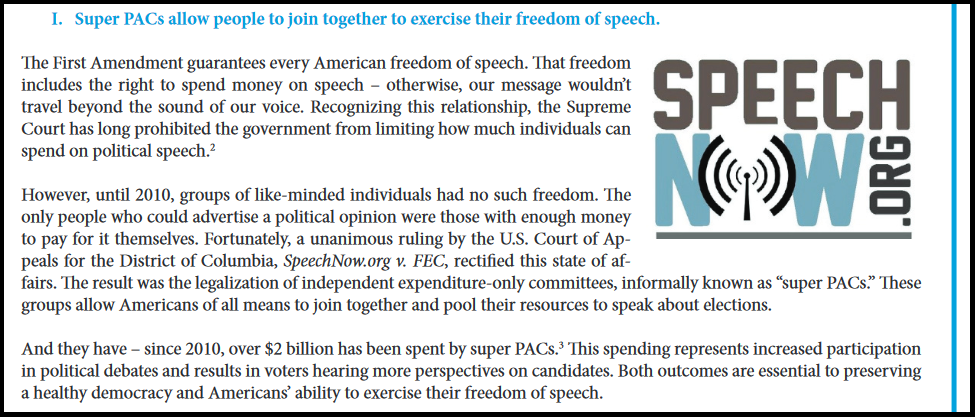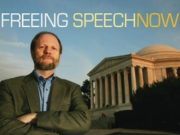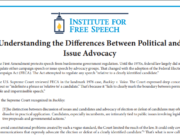“[T]he government can have no anti-corruption interest in limiting contributions to independent expenditure–only organizations.”
– SpeechNow.org v. Federal Election Commission[1]
The product of a 2010 court ruling, “super PACs” have been a boon to citizens wishing to more effectively speak about elections. Legally, they have ensured that Americans do not lose their First Amendment rights when they join together in groups. In practice, they have challenged the monopoly on political speech held by powerful politicians and big media corporations.
Yet, despite their importance, super PACs are often misunderstood. What is the constitutional basis for super PACs, what role do they play, and what rules must they follow? This Issue Brief answers those three important questions.
Three Key Facts about Super PACs
I. Super PACs allow people to join together to exercise their freedom of speech.
The First Amendment guarantees every American freedom of speech. That freedom includes the right to spend money on speech – otherwise, our message wouldn’t travel beyond the sound of our voice. Recognizing this relationship, the Supreme Court has long prohibited the government from limiting how much individuals can spend on political speech.[2]
However, until 2010, groups of like-minded individuals had no such freedom. The only people who could advertise a political opinion were those with enough money to pay for it themselves. Fortunately, a unanimous ruling by the U.S. Court of Appeals for the District of Columbia, SpeechNow.org v. FEC, rectified this state of affairs. The result was the legalization of independent expenditure-only committees, informally known as “super PACs.” These groups allow Americans of all means to join together and pool their resources to speak about elections.
And they have – since 2010, over $2 billion has been spent by super PACs.[3] This spending represents increased participation in political debates and results in voters hearing more perspectives on candidates. Both outcomes are essential to preserving a healthy democracy and Americans’ ability to exercise their freedom of speech.
II. Super PACs create a more open political system, which was previously controlled by politicians and the media.
Prior to the creation of super PACs, campaign speech was dominated by a small set of elite institutions: the media, the political parties, and the candidates themselves. Unless you were participating in one of these groups or were extremely wealthy, the law effectively prevented you from promoting your political opinion.
The creation of super PACs reduced the power of these “gatekeeper” institutions to filter political speech. Now any group of citizens has a chance to offer their views in competition with party leaders and the media.
Despite this, the largest sources of campaign spending are still the usual suspects. In both 2014 and 2016, over 75% of election-related spending came from candidates, parties, and traditional political action committees.[4] That figure doesn’t include the value of media coverage, which is estimated to be worth billions of dollars.[5] Super PACs, though significant, account for only a fraction of total political spending. Still, their presence affords Americans the opportunity to better compete with more privileged institutions and candidates.
III. Super PACs report their spending and donors, the vast majority of whom are individuals.
Super PACs are not subject to contribution limits and can accept donations from corporations and unions. They are free to do so because super PACs do not give money to candidates or parties, and do not coordinate their spending with these entities. However, super PACs are still heavily regulated by campaign finance laws.
Just like candidates and political parties, super PACs must report the names, addresses, occupations, and employers of all their donors who contribute over $200. They must also register with the Federal Election Commission and report all of their donations and spending on a schedule set forth by the government. This information is then published online in a searchable database available to anyone.
These reports show that individuals are by far the largest source of super PAC funds. In the 2015-2016 election cycle, individuals accounted for 68% of the funds given to super PACs.[6]
Conclusion
Super PACs have been given a bad name by their competitors – politicians and big media companies accustomed to dominating the debate. In reality, super PACs allow Americans to more effectively exercise their First Amendment right to express opinions about candidates. They allow anyone who wishes to join together to advertise their opinion in greater competition with elite institutions. And although they are free from contribution limits, super PACs are still subject to campaign finance laws, must publicly report their donors, and ultimately account for only a fraction of total political spending.
Our democracy is better off when Americans can join together and speak as a group about the issues that unite them. Voters are better off when they can hear opinions beyond those shared by politicians, political parties, and the media. Super PACs are here to stay, and that’s a welcome development for anyone who believes in free political speech.
[1] SpeechNow.org v. Federal Election Commission, 599 F.3d 686, 696 (D.C. Cir. 2010) (en banc) (“[T]he government can have no anti-corruption interest in limiting contributions to independent expenditure–only organizations.”).
[2] Buckley v. Valeo, 424 U.S. 1 (1976).
[3] See “Outside Spending, by Super PAC,” Center for Responsive Politics. Retrieved on October 17, 2017. Available at: https://www.opensecrets.org/outsidespending/summ.php?chrt=V&type=S (September 28, 2017). The over $2 billion figure was obtained by summing the “total spent by super PACs” statistic from the 2010 through the 2018 cycles.
[4] “The Landscape of Campaign Contributions: Campaign Finance after Citizens United,” Committee for Economic Development. Retrieved on October 17, 2017. Available at: https://www.ced.org/pdf/TCB-CED-The-Landscape-of-Campaign-Contributions.pdf (July 2017), p. 2.
[5] Scott Blackburn, “Five Lessons about Spending in the 2016 Campaign You Might Have Missed,” Institute for Free Speech. Retrieved on October 17, 2017. Available at: https://www.ifs.org/2017/04/19/five-lessons-about-spending-in-the-2016-campaign-you-might-have-missed/.
[6] “The Landscape of Campaign Contributions: Campaign Finance after Citizens United,” Committee for Economic Development. Retrieved on October 17, 2017. Available at: https://www.ced.org/pdf/TCB-CED-The-Landscape-of-Campaign-Contributions.pdf (July 2017), p. 20.














